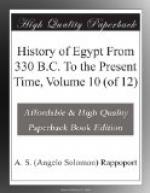On another chariot, drawn by an elephant, came Osiris, as he returned from his Indian conquests. He was followed by twenty-four chariots drawn by elephants, sixty drawn by goats, twelve by some kind of stags, seven by gazelles, four by wild asses, fifteen by buffaloes, eight by ostriches, and seven by stags of some other kind. Then came chariots loaded with the tributes of the conquered nations; men of Ethiopia carrying six hundred elephants’ teeth; sixty huntsmen leading two thousand four hundred dogs; and one hundred and fifty men carrying trees, in the branches of which were tied parrots and other beautiful birds. Next walked the foreign animals, Ethiopian and Arabian sheep, Brahmin bulls, a white bear, leopards, panthers, bears, a camelopard, and a rhinoceros; proving to the wondering crowd the variety and strangeness of the countries that owned their monarch’s sway.
In another chariot was seen Bacchus running away from Juno, and flying to the altar of Rhea. After that came the statues of Alexander and Ptolemy Soter crowned with gold and ivy: by the side of Ptolemy stood the statues of Virtue, of the god Chem, and of the city of Corinth; and he was followed by female statues of the conquered cities of Ionia, Greece, Asia Minor, and Persia; and the statues of other gods. Then came crowds of singers and cymbal-players, and two thousand bulls with gilt horns, crowns, and breast-plates. Then came Amon-Ra and other gods; and the statue of Alexander between Victory and the goddess Neith, in a chariot drawn by elephants: then a number of thrones of ivory and gold; on one was a golden crown, on another a golden cornucopia, and on the throne of Ptolemy Soter was a crown worth ten thousand aurei, or nearly thirty thousand dollars; then three thousand two hundred golden crowns, twenty golden shields, sixty-four suits of golden armour; and the whole was closed with forty waggons of silver vessels, twenty of golden vessels, eighty of costly Eastern scents, and fifty-seven thousand six hundred foot soldiers, and twenty-three thousand two hundred horse. The procession began moving by torchlight before day broke in the morning, and the sun set in the evening before it had all passed on its way.
[Illustration: 106.jpg BRONZE COSMETIC HOLDER]
It went through the streets of Alexandria to the royal tents on the outside of the city, where, as in the procession, everything that was costly in art, or scarce in nature, was brought together in honour of the day. At the public games, as a kind of tax or coronation money, twenty golden crowns were given to Ptolemy Soter, twenty-three to Berenice, and twenty to their son, the new king, beside other costly gifts; and two thousand two hundred and thirty-nine talents, or one million seven hundred and fifty thousand dollars, were spent on the amusements of the day. For the account of this curious procession we are indebted to Callixenes of Rhodes, who was then travelling in Egypt, and who wrote a history of Alexandria.




